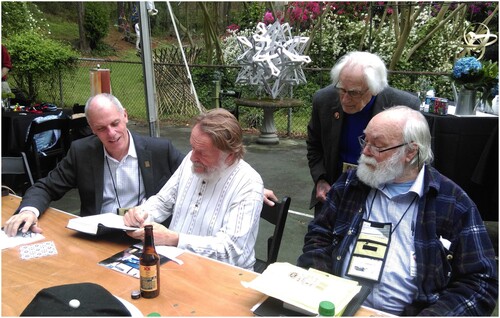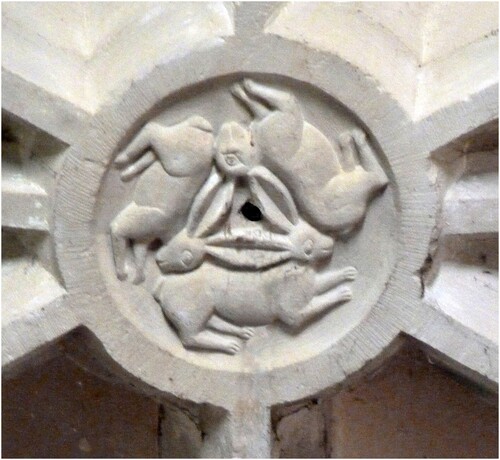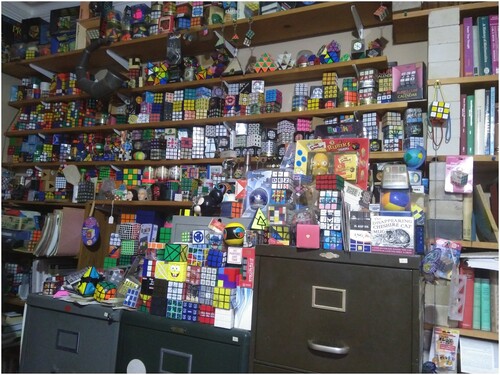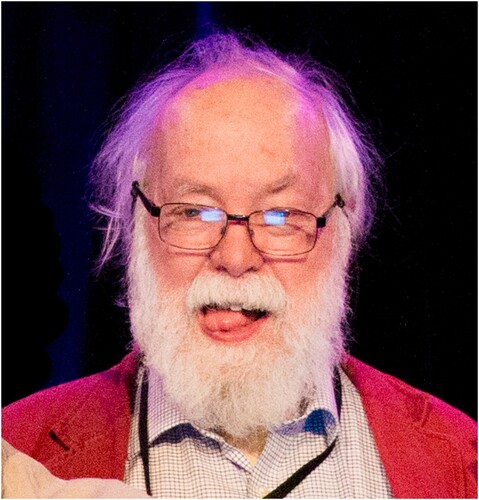The world of Recreational Mathematics has lost a giant … David Singmaster, the self-styled ‘Metagrobologist’, has left us.
Some years ago, at the MathsJam Annual Gathering, David Singmaster ambled up to one of the other delegates. ‘Nice t-shirt,’ he said. The design showed the small robot from Star Wars, companion to C3PO, perhaps best known for his beeps and whistles. But instead of his usual cylindrical body, in its place was a Rubik's Cube, and printed underneath was the name: R2D2.
‘Yes!’ said the delegate, clearly delighted that someone had noticed, ‘But it's even cleverer than you might think. See, the robot's name is R2D2, but that's also a move in the notation we use for solving the cube!’
David chatted with them for a while, during which time the truth slowly emerged. The notation in question is called the Singmaster notation, invented by David in late 1978 during his process of devising a method of solving (or restoring) the cube. And so the delight increased … to meet the man who'd brought a method of solving the cube to a world of enthusiasts ().
It's via the cube that most people will have encountered David, but if you met him in person it soon became clear that his interests went way beyond that one object. I don't remember when I first met him, but I remember spending some time with him at the Gathering For Gardner in 2008. He had a new (both to him and to me) toy that we call ‘The Ring on a Chain’. He was both practising how to do it, and delightedly showing it to anyone in range, sometimes even getting it right.
This was the theme … David had a delight and a passion for sharing. A visit to his house was an adventure, and once you were there it was extraordinarily difficult to leave! It was packed, floor to ceiling, with books, puzzles, and games. ‘Just one more thing’ was his catchphrase, as he would first show, then watch you struggle with, then himself struggle in turn to remember how to solve a mechanical puzzle of one sort or another. His tongue would poke out, first on one side, then the other, then back again, as all the while he talked about the history of the item, and how it had come into his possession. He delighted in the struggle, and each time he succeeded in solving a puzzle again his joy was evident, and you were invited to share it with him ().
There was much more to him than just puzzles.
Born in Missouri, USA, he started his academic studies at the California Institute of Technology where his initial intention was to be a civil engineer. But then he became interested in chemistry, then distracted by physics, and finally he was ‘asked to leave’ due to his ‘lack of academic ability’. He took a year off, then enrolled at the University of California at Berkeley, where some final year courses in mathematics caught his interest. During his time there he solved a prize problem in his number theory course, and then another problem that eventually led to two academic papers. It then only seemed reasonable that he would continue his studies, leading to a PhD in number theory from Berkeley, supervised by Dick Lehmer and R. Sherman Lehman.
After his PhD Singmaster travelled for a time. He taught at the American University of Beirut, and lived for a while in Cyprus, before moving to London in 1970, where he became a lecturer in mathematics at the newly formed ‘Polytechnic of the South Bank’. His academic disciplines were Combinatorics and Number Theory.
As a side-line, in the Summer of 1971 he joined an underwater archaeological expedition led by Honor Frost, investigating the area off the coast of Marsala, Sicily. He was the expedition photographer, and during one dive when he went off course to retrieve a stray marker, he found a timber sticking out of the sand. Drawing the attention of the expedition leaders to it, it transpired that he had discovered a mid-third century BCE Punic shipwreck, now dubbed the Marsala Punic Ship.Footnote1 This was not atypical of David. His interests were wide, his curiousity apparently endless, and his observational skills were sharp.
David is also known for Singmaster's Conjecture. In the pattern we know as Pascal's Triangle (despite it being known centuries before Pascal), every number greater than ‘1’ will appear, and each will appear only finitely many times. But David noticed that no number seemed to turn up very often. He conjectured that there is some fixed finite bound on how often a number can appear, a conjecture that remains unresolved. So far, it has been found that the number 3003 appears eight times … no other number is known to turn up as often … and while there are many related questions, almost all remain open.
It was during his time at the South Bank Polytechnic when David was first introduced to The Rubik's Cube. After acquiring one in August 1978 he managed to solve it within ‘two weeks, on and off’. He devised a general solution, inventing the notation mentioned above for recording moves, a notation that is still used today. In October 1979 he published his Notes on the ‘Magic Cube’. This showed how to construct a solution using basic group theory, and explored some of the mathematics underlying his solution, and the cube in general. By 1981 he was spending almost all of his time on cube-related activities, and for the next four years published a quarterly newsletter called the Cube Circular. This included reports on early speedcubing competitions, on the first World Championship, extensive analyses of the mathematics of the cube, the so-called God's algorithm, new variants, and more.
David's knowledge of ‘the history of puzzles (among many other things) was extensive, as was his network of connections. He was friends with John Conway, Richard Guy, Martin Gardner, and many others, and he was right at home with them, as he was with anyone else who loved puzzles, games, maths, and toys. He was kind and welcoming to all who would engage. David was also quick and incisive. On more than one occasion, at various gatherings such as the Annual MathsJam, or the Gathering for Gardner, a puzzle would be proposed and he would give an answer within seconds. Sometimes it was because it was similar to a puzzle he'd seen before – and it felt like he had seen them all! But sometimes it was simply because he had solved it there, on the spot. This could make him challenging company, but if you were willing to go along for the ride it was immensely rewarding, for he was free with his knowledge, and his enthusiasm was undeniable and irresistibly infectious’ ().
Figure 3. Left to right: John Railing, John Conway, Richard Guy, David Singmaster. Image: Colin Wright

He was also an avid collector. His book collection has something in the vicinity of 10,000 books, including works on recreational maths, the history of maths, plus a range of cartoons, humour, and language. His collection of mechanical puzzles is extensive, including (of course) many, many examples of, and variants on, the Rubik's Cube. Having written the first book outlining a method of restoring the cube, and devising the notation that is almost universally used, people often sent him early versions of new modifications. An extension to the house was constructed to hold the collection – an extension that has been amply filled.
In 1984 David obtained a copy of Propositiones ad acuendos juvenes (Problems to Sharpen the Young). This is the oldest known mathematical problem collection in Latin, and is attributed to Alcuin of York. David collaborated with John Hadley, a Catholic priest, to translate the text, and to add annotations and a commentary.Footnote2 It is a collection of major historical interest, and it is no surprise that David was involved in making it available.
Perhaps slightly less expectedly, David was also interested in the ‘Motif of the Three Hares’, a design in which there are three hares following each other in a circle. They each have the requisite two ears, but each shares an ear with another, so there are only three ears in total. There is some evidence that this was presented as a puzzle in ancient times, but it has also appeared in many unexpected places as a motif of some sort. It is unclear whether it was purely decorative, or intended to convey a message and carry meaning. David showed me a splendid coffee table book, which he had contributed to, about a journey along the Silk Road tracking down places where the three hares had been found. This went some way to explaining why his ever-present bag of toys had the three hares appliquéd on it ().
Figure 4. Motif of the Three Hares on a ceiling boss in the early sixteenth-century Eglise d'Anjeux. Ti'Michel, CC BY-SA 4.0. https://creativecommons.org/licenses/by-sa/4.0, via Wikimedia Commons

David was full of surprises like that, but for those who were lucky enough to get to know him it was somehow less surprising. His interests were as unbounded as his youthful enthusiasm. Peter Rowlett recalled an occasion where he spent some time with David:
… a group of us went to the Royal Observatory. I remember we didn't need to read any of the signs, David treated us to a running commentary of many interesting stories about the objects in the museum. … I remember how excited he was when I told him I had gained approval to run an undergraduate module on recreational mathematics … He was a positive force in both the history of maths and recreational maths worlds … .
In 1992 the ‘South Bank Polytechnic’ evolved into the ‘London South Bank University’, and Singmaster was the professor of mathematics at the ‘School of Computing, Information Systems and Mathematics’. He formally retired in 1996, and became an honorary research fellow at University College London, later appointed emeritus at London South Bank University in 2020.
But he certainly never retired from his research in recreational mathematics and in the history of games and puzzles. In 2007 he found a reference in a nineteenth-century manuscript, and following that led to the re-discovery of ‘De viribus quantitatis’ (On The Powers Of Numbers).Footnote3 Written by Luca Pacioli, a Franciscan friar who lived around 1500, this is one of the world's oldest books on puzzles and magic illusions. In 2016 he published a collection of his puzzles: ‘Problems for Metagrobologists.’
To paraphrase Rob Eastaway: David will be greatly missed by everyone who knew him, but his spirit will live on whenever someone casually picks up a Rubik's cube, smiles, and starts to play with it.
David Singmaster’s involvement in history of mathematics, by Tony Mann
David organized and contributed to many BSHM events over the years. He gave at least twelve talks to BSHM meetings, his subjects including ‘The Magic Cube’ in 1979 (presumably a very early talk about what is now known as ‘Rubik’s Cube') and many other topics in recreational mathematics. He organized the meeting on ‘History of Recreational Mathematics’ at South Bank University in 1996. He last talked to the BSHM in May 2019 at the Birkbeck meeting on the History of Recreational Mathematics. His topic was ‘The 17 camels and the 13 camels’.
Longstanding BSHM members will recall David’s ‘Mathematical Gazetteer of the United Kingdom’ which was serialized in the BSHM Newsletter between numbers 25 (Spring 1995) and 43 (Summer 2001). Subsequent parts of the Gazetteer did not appear in the Newsletter but it was published in full on the Society’s website, being completed by January 2003. It disappeared when the website was redesigned in 2007.Footnote4 David introduced the Gazetteer as follows: ‘For some years I have been collecting information about where mathematicians were born, lived, worked, died, or are buried or commemorated’, and many members enjoyed browsing as well as looking for specific information.
Among David’s 60 or so publications devoted to puzzles and listed on MathSciNet, at least 10 are specifically historical. Much of this work forms the basis of the two-volume Adventures in recreational mathematics published in 2021–2022, shortly before he died.Footnote5 The freely available sample chapter, ‘Why recreational mathematics’ gives a splendid idea of the breadth and depth of David’s remarkable knowledge.Footnote6
Notes
1 https://artsandculture.google.com/story/the-discovery-of-the-marsala-punic-ship-honor-frost-foundation/2QWhIN7Uu9SK-Q. https://en.wikipedia.org/wiki/Marsala_Punic_shipwreck.
2 Hadley and Singmaster (Citation1992).
4 These days the Gazetteer is available at https://mathshistory.st-andrews.ac.uk/Gaz/; David Singmaster is credited, and a link to the archived BSHM version on the Wayback Machine is provided.
5 Singmaster (Citation2021, Citation2022).
6 Sample chapter: David Singmaster, ‘Why Recreational Mathematics’ https://doi.org/10.1142/9789811226045_0001.
Bibliography
- Hadley, John, and Singmaster, David, ‘Problems to sharpen the young’, The Mathematical Gazette, 76 (1992), 102–126. https://www.jstor.org/stable/3620384.
- Singmaster, David, Adventures in recreational mathematics, Singapore: World Scientific, Vol. 1, 2021.
- Singmaster, David, Adventures in recreational mathematics, Singapore: World Scientific, Vol. 2, 2022.


